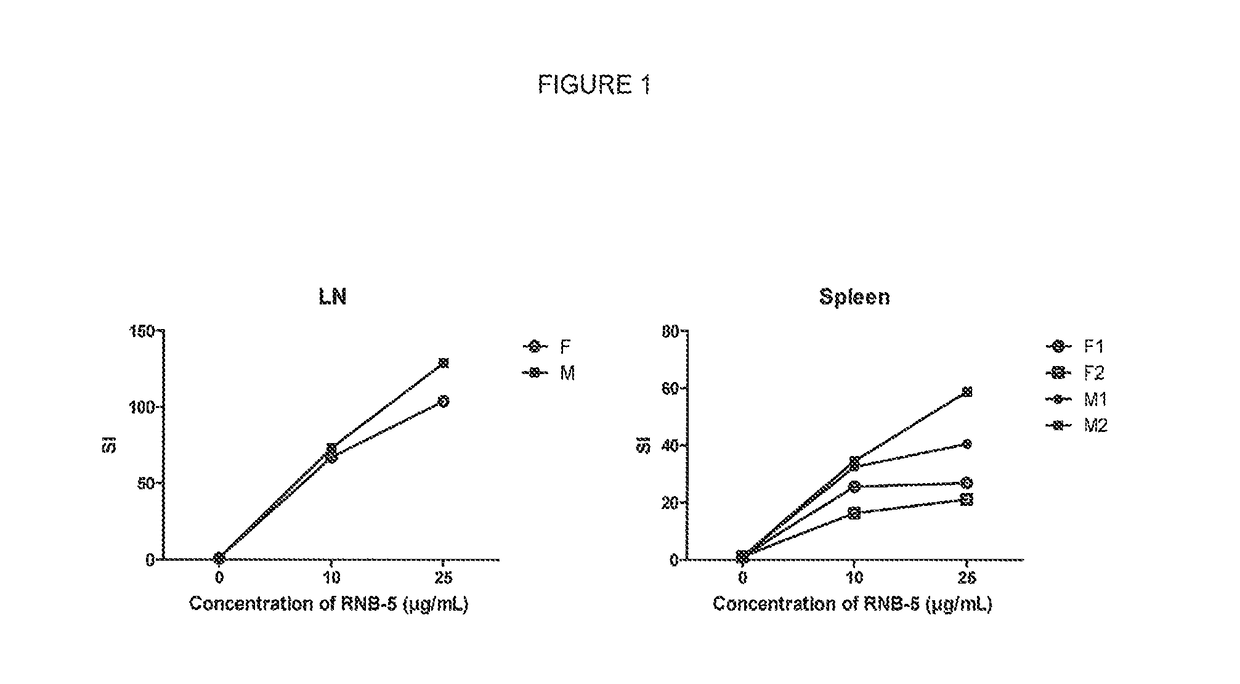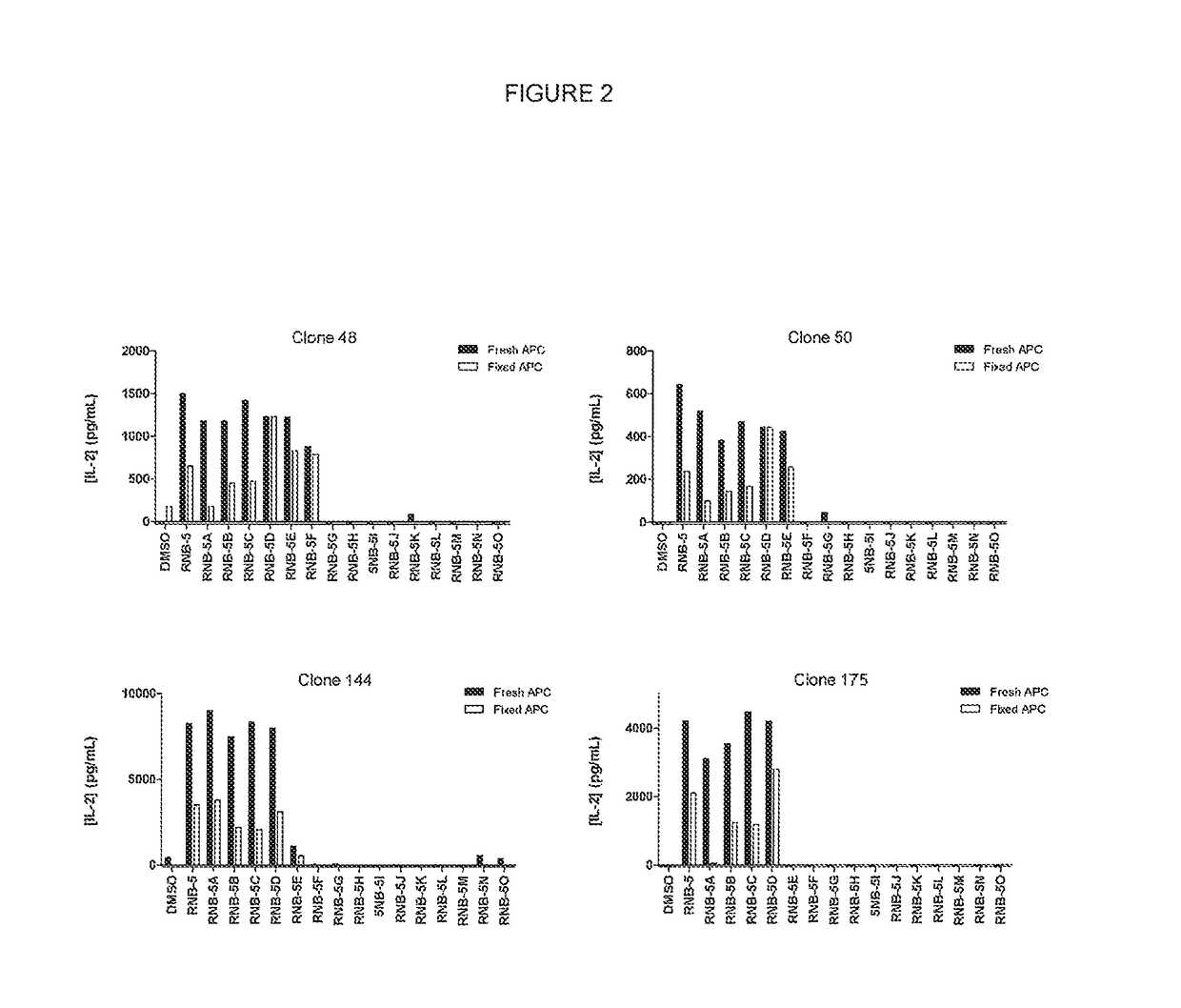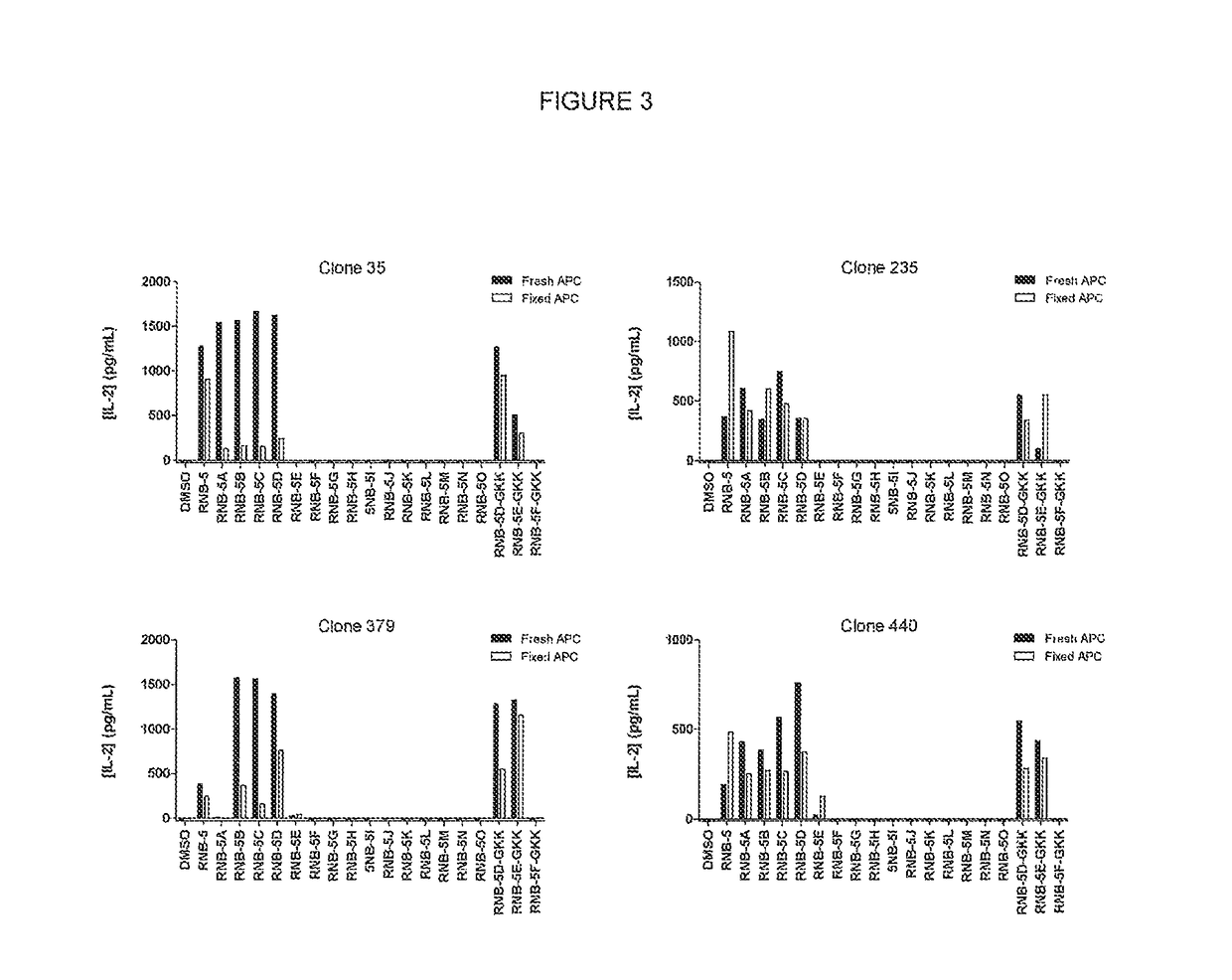Peptides
a technology of peptides and peptides, applied in the field of peptides, can solve the problems of enlargement of the thyroid gland, production of an excessive amount of thyroid hormone, severe dryness of the cornea, and vision loss, and achieve the effect of improving solubility
- Summary
- Abstract
- Description
- Claims
- Application Information
AI Technical Summary
Benefits of technology
Problems solved by technology
Method used
Image
Examples
example 1
of HLA-DR3 TSHR Peptides
[0157]To identify important epitope regions in the TSHR, the ECD of the TSHR (AA20-418) was divided in 28 overlapping peptides of 28-30 amino acids (28-30-mers) overlapping by 15 amino acids, as shown below.
[0158]
[0159]
LengthSEQName(AA)SequenceID NORNB-129GGMGCSSPPCECHQEEDFRVTCKDIQRIP 79RNB-230EEDFRVTCKDIQRIPSLPPSTQTLKLIETH 80RNB-330SLPPSTQTLKLIETHLRTIPSHAFSNLPNI 81RNB-429LRTIPSHAFSNLPNISRIYVSIDVTLQQL 2RNB-529ISRIYVSIDVTLQQLESHSFYNLSKVTHI 1RNB-629ESHSFYNLSKVTHIEIRNTRNLTYIDPDA 82RNB-729EIRNTRNLTYIDPDALKELPLLKFLGIFN 83RNB-829LKELPLLKFLGTENTGLKMFPDLTKVYST 84RNB-929TGLKMFPDLTKVYSTDIFFILEITDNPYM 3RNB-1030TDIFFILEITDNPYMTSIPVNAFQGLCNET 85RNB-1128TSIPVNAFQGLCNETLTLKLYNNGFTSV 86RNB-1228LTLKLYNNGFTSVQGYAFNGTKLDAVYL 64RNB-1328QGYAFNGTKLDAVYLNKNKYLTVIDKDA 87RNB-1428NKNKYLTVIDKDAFGGVYSGPSLLDVSQ 88RNB-1528FGGVYSGPSLLDVSQTSVTALPSKGLEH 89RNB-1628TSVTALPSKGLEEILKELIARNTWTLKKL 90RNB-1728LKELIARNTWTLKKLPLSLSFLHLTRAD 91RNB-1828PLSLSFLHLTRADLSYPSHCCAFKNQKK 92RNB-1928LSYPSHCCA...
example 2
ation of Apitopes within RNB-5
[0163]To determine the exact epitope position within RNB-5, a panel of 15-mer overlapping peptides spanning RNB-5 was synthesized using standard F-moc chemistry. Each peptide was displaced by 1 amino acid, as shown below:
[0164]
SEQNameSequenceID NORNB_5AISRIYVSIDVTLQQL 6RNB_5BSRIYVSIDVTLQQLE 7RNB_5CRIYVSIDVTLQQLES 8RNB_5DIYVSIDVTLQQLESH 9RNB_5EYVSIDVTLQQLESHS 10RNB_5FVSIDVTLQQLESHSF 11RNB_5GSTDVTLQQLESHSFY103RNB_5HTDVTLQQLESHSFYN104RNB_5IDVTLQQLESHSFYNL105RNB_5JVTLQQLESHSFYNLS106RNB_5KTLQQLESHSFYNLSK107RNB_5LLQQLESHSFYNLSKV108RNB_5MQQLESHSFYNLSKVT109RNB_5NQLESHSFYNLSKVTH110RNB_5OLESHSFYNLSKVTHI111
[0165]
SEQNameModified sequenceID NORNB_5D-GKKKKGIYVSIDVTLQQLESHGKK 12= RNB_5D_G0RNB_5E-GKKKKGYVSIDVTLQQLESHSGKK 13RNB_5F-GKKKKGVSIDVTLQQLESHSFGKK 14RNB_5D_KKKKKKIYVSIDVTLQQLESHKKK 21= RNB_5D_K0RNB_5D_G1KKGKYVSIDVTLQQLESHGKK 22RNB_5D_G2KKGIKVSIDVTLQQLESHGKK 23RNB_5D_G3KKGIYKSIDVTLQQLESHGKK 24RNB_5D_G4KKGIYVKTDVTLQQLESUGKK112RNB_5D_G5KKGIYVSKDVTLQQLESHGKK113RN...
example 3
olerance Assay
[0176]To assess the ability of the RNB-5 apitopes to induce tolerance, the ability of these apitopes to inhibit the immune response was first investigated in healthy HLA-DRB1*0301 or HLA-DRB1*0401 mice ex vivo. Mice were pretreated with different RNB-5 apitopes according to the high-dose or the dose-escalation schedule, as described in the method section. The studies showed that pre-treatment with RNB-5 apitopes significantly reduce TSHR-induced T cell proliferation, both in DR3 and DR4 mice (FIG. 6A-D). RNB-5 DEF nested peptides were modified by adding amino acids ‘GKK’ on both the C- and N-terminus. Pre-treatment with these modified apitopes also significantly reduced TSHR-induced T cell proliferation (FIG. 6E-F).
[0177]Peptides RNB-9A to 9D were predicted to bind strongly to HLA-DRB1*0301 molecules and their ability to induce specific immune tolerance was also investigated. DR3 mice were pretreated with RNB-9A to 9D according to the dose-escalation schedule. RNB-9B a...
PUM
| Property | Measurement | Unit |
|---|---|---|
| concentrations | aaaaa | aaaaa |
| concentrations | aaaaa | aaaaa |
| temperature | aaaaa | aaaaa |
Abstract
Description
Claims
Application Information
 Login to View More
Login to View More - R&D
- Intellectual Property
- Life Sciences
- Materials
- Tech Scout
- Unparalleled Data Quality
- Higher Quality Content
- 60% Fewer Hallucinations
Browse by: Latest US Patents, China's latest patents, Technical Efficacy Thesaurus, Application Domain, Technology Topic, Popular Technical Reports.
© 2025 PatSnap. All rights reserved.Legal|Privacy policy|Modern Slavery Act Transparency Statement|Sitemap|About US| Contact US: help@patsnap.com



